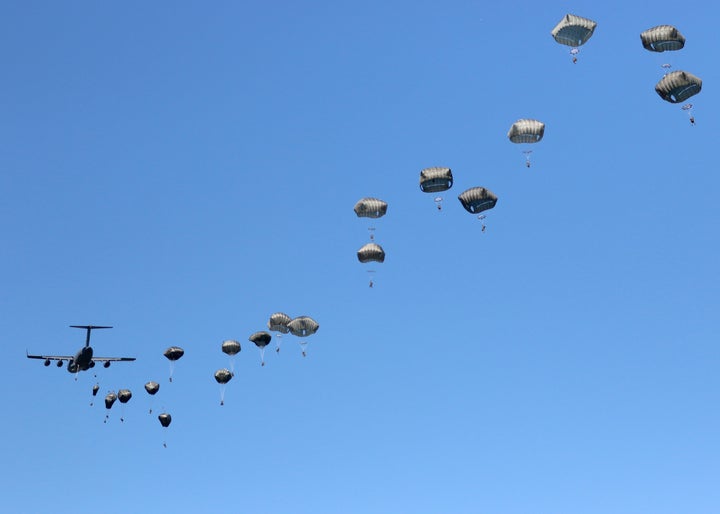Senior Military Correspondent David Wood recently flew to Europe with paratroopers of the 82nd Airborne Division’s 1st Brigade Combat Team for a massive military exercise involving 5,000 soldiers from 10 allied nations. Safely tethered, he stood by the door and watched them jump.
Going out the aircraft door at a thousand feet over the farmland of central Poland, strapped to a parachute and 130 pounds of combat gear, turns out to be the easy part.
A relief, in fact, after a 10-hour flight from Fort Bragg, North Carolina, strapped into fold-down seats along the edges of the C-17 cargo jet’s immense hold and dozing until a few hours out from the drop zone. Then struggling to your feet, shrugging on the 55-pound parachute and balancing in mild turbulence to strap the rucksack between your legs, weapons case by your left leg and auxiliary chute on your chest. An Army rigger checking each paratrooper, fussing like a medieval squire helping his knight into a suit of armor. The riggers running a finger along each strap to trace out any kinks or loose ends, tugging on each steel snap link and shackle, smoothing knots -- nothing here to snag on your way out. Recoiling the 15 feet of static line that you’ll clip onto the overhead steel cable so that as you drop, your chute is yanked out. Until then, the loops of that yellow web strap are held in place by rubber bands, which will snap as you go.
And you go at one-second intervals -- waddling up to the doorway, pushing off and immediately tucking into an L shape, knowing pretty quickly if there’s a problem or you’re good.
The first seconds of the exit from the aircraft are the tricky part. Any number of things can go wrong. The worst is probably "a tow": You get out the door OK, but some piece of equipment gets caught and you’re still attached to the airplane, helplessly flailing along at 150 miles an hour behind the jet engines.
That’s why a common good-luck comment here isn’t “Have a safe landing,” but “Have a good exit.”

Long before any paratroopers are dropping out of the sky, an airborne operation requires some seriously detailed planning. The color-coded checklist of things to do runs over 5,000 items.
The paratroopers of the 82nd Airborne are good at this. They have to be, because their job is to deploy at a moment's notice, faster than any other Army or any Marine units.
For this particular training mission, nine C-17s are lined up in the nighttime darkness. The checklist guides the loading of each aircraft so that the heavy stuff -- the artillery pieces, Humvees and pallets of supplies -- goes out on the first pass over the drop zone. You don't want a howitzer landing on somebody. Then the paratroopers jump in sequence, so that members of a platoon flying on separate aircraft all land near the same spot, and Humvee drivers land near their vehicles.
Also on the checklist: calculations on when and where to meet the aerial refuelers; computations on wind and weather; permissions to enter foreign air space (on this mission, Canada, Britain, Denmark, Sweden, Poland); rendezvous procedures with protective jet fighters; and the maneuver scheme for military exercises on the ground.
What actually happens this time is not on the checklist: Of the nine C-17s, one cannot start an engine and is sidelined. Another trundles down the runway, only to abort takeoff because of a malfunction. The next plane has to abort because of the one that halted in front of it. Result: a third of the planes, paratroopers and gear are left behind, and the old adage that “no plan survives collision with reality” is proved true again.
The military celebrates its ability to adapt, so the remaining force takes flight. Some 10 hours later, cargo and paratroopers descend over the Polish drop zone. It's little more than a mile in length, short enough that each C-17 has only 22 seconds per pass, even at what seems like a crawling speed of 150 mph.
If the United States needs to put lethal force someplace in the world in a hurry, this is how it’s done. Paratroopers, who all volunteered for Jump School, train for this constantly. One battalion is always on short alert. The “ready cage” at Fort Bragg is a warehouse crammed with gear -- everything from Humvees to ammo, artillery, water -- already packed on pallets with their own chutes attached. Eighteen hours for the ready battalion to assemble, load and go. Thirty-six hours and an entire brigade's 4,300 paratroopers are in the air.
Then the jump, the easy part.
Once everybody is on the ground, the real action starts. As Col. Anthony G. Judge, the 82nd Airborne Division’s operations chief, is fond of saying:
“Jump, fight tonight and win against any adversary any time.”

